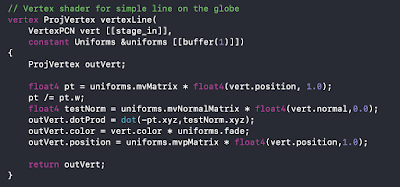I'm in the middle of the 3.0 upgrade to WhirlyGlobe-Maply. As a
reminder, this is bringing the Android version up to speed with iOS and then implementing Metal support for iOS. On the way, I'm cleaning up a ton of old technical debt.
So where are we now?
The Android Port
This month was all about Android: Start with the test cases from iOS, trim the silly or pointless ones, move the rest to Android.
As boring as it sounds. Let's look at a picture.
So yes, it's working. This is the new data logic (Sampler/Loader) and it's just a ton faster and cleaner.
Even though the pyramid image tile loading is what most people use, there's a lot more to the system. I'm steadily working my way through it. Behold the glory of my spreadsheet!
The green is done, but may have a bug or two. The mustard is in process and white hasn't been addressed yet. There's about a week to go.
Android Internals & Development Flow
The original Android port was a janky affair. It was built using Eclipse and the last generation of Native SDK build tools. For my part the Java Native Interface logic was.... uneven.
Version 3.0 was an opportunity to clean all that up. The switch to Android Studio and CMake (in 2.6) was a huge improvement already.
It's really the debugging in Studio that makes it so much more pleasant. I can reliably set breakpoints on both Java and C++ sides. And Studio only crashes every few hours.
But the point of it all was a shared C++ core. After
The Port No One Wants, I had that and I've been busily wiring it up on the Android side. So if you see a MapboxVectorTileParser_iOS wrapper object, you can find an equivalent MapboxVectorTileParser_Android for talking to Java. And they mostly work the same.
I've also simplified much of the Java/C++ interface. There are fewer Java callbacks holding fewer Java objects on the C++ side. Simple data marshaling, like conversion to arrays, is handled on the Java side. Stuff like that cuts way down on possible bugs.
As a result, I can debug on one platform and expect the fix to pop up on the other. Multiple times I've fixed something on Android and then verified it on iOS. That's new.
Wither Kotlin
Did I say Kotlin? I didn't, but sure. Am I rewriting everything in Kotlin and using the Native Kotlin transpiler to rewrite the C++ side and then using that on iOS? No. Seriously. No. Calm down.
I am writing new AutoTester MaplyTestCase modules in Kotlin, though. It's pretty nice!
What's Next & Thanks
After a round of conference & vacation, iOS Metal is up next. I'll start real development in a couple weeks and should wrap up June-ish.
Metal started the 3.0 effort so a big thanks to Apple for threatening to casually break everything. That kicked the party off.
But more seriously, a big thanks to the sponsors of the 3.0 effort. We've all worked together a while now and I appreciate your faith in me, and more importantly, your ability to pay my invoices. WhirlyGlobe-Maply 3.0 is going to do great things for your apps!








